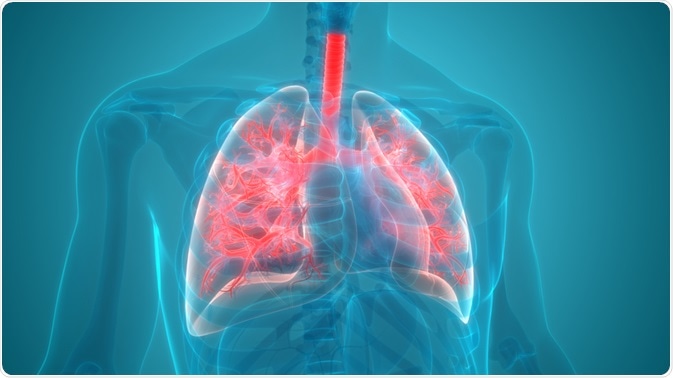What is pneumonia?
Pneumonia is an infection of one or both lungs which affects alveoli, the tiny sacs found in clusters at the end of the branching structure of airways (respiratory tree) that supply air to the lungs. Alveoli have very thin walls and are surrounded by capillaries that allow inhaled oxygen to be diffused into the bloodstream, and carbon dioxide to be removed and exhaled.

Human Respiratory System. Image Credit: Magic mine/Shutterstock.com
Pneumonia, which is one of a group of alveolar lung diseases, causes alveoli to become inflamed and fill with fluid or pus, which interferes with this gas exchange. Common symptoms of pneumonia include:
- A frequent cough which produces sputum, a mixture of saliva, mucus, and pus. Sputum is usually either clear, greenish, or yellowish, but can contain blood which is indicative of a severe infection.
- Pain or pressure under the breastbone which becomes more intense when coughing or upon taking deep breaths.
- Fever, or sweating and chills.
- Difficulty breathing and shortness of breath and rapid heartbeat, even during inactivity.
Pneumonia affects all ages but is more common and more severe in the elderly or very young. The risk of developing pneumonia is increased for people who smoke, people with long-term health conditions such as asthma or cystic fibrosis, and people with compromised immune systems. These groups are also significantly more likely to develop complications of pneumonia which may include:
- Pleurisy, an inflammation of the membrane covering the chest cavity and outside of the lungs which may lead to respiratory failure.
- Lung abscesses, seen when lung tissues necrotize and form cavities containing necrotic debris. Referred to as necrotizing pneumonia, this is a rare complication usually observed in patients with a serious pre-existing disease or chronic alcohol misuse.
- Sepsis, an extreme bodily response to infection that can lead to tissue damage and organ failure. Although developing sepsis following pneumonia is rare, pneumonia is the most common cause of a septic episode.
Causes of pneumonia
The commonest causes of pneumonia acquired in the community are from either viral or bacterial pathogens. Together, these are estimated to account for between 21% and 77% of all cases of community-acquired pneumonia (CAP). Viral pneumonia is more prevalent and accounts for between 13% and 50% of cases and bacterial pneumonia accounts for between 8% - 13%.
Distinguishing between viral and bacterial CAP can be challenging as both share similar symptoms and biomarkers. However, as some forms of bacterial pneumonia can be prevented with vaccines, whereas viral pneumonia can only be prevented by following basic hygiene principles, differentiating between the two is critical.
Viral pneumonia
Viral pneumonia is defined as a disease whereby the oxygen and carbon dioxide gas exchange at the level of the alveoli is abnormal, and such abnormality is caused by a viral pathogen. It is typically accepted as a final common pathway of infection, as it develops following another primary infection. Owing to this, the number of viruses that can lead to viral pneumonia are plentiful, but the commonest cause is the influenza virus in adults and the respiratory syncytial virus in children.
It can occur via the following mechanisms:
- Direct imbuement of a viral particle into the lung,
- Contagious spread from a viral infection close to the respiratory tract (for example, measles),
- Contagious spread from a distant viral infection.
Bacterial pneumonia
Bacterial pneumonia is diagnosed when an abnormality in the oxygen-carbon dioxide gas exchange is attributed to a bacterium. The Streptococcus pneumoniae bacterium is responsible for most cases of bacterial CAP, although Enterobacteriaceae such as E-coli and Methicillin-resistant Staphylococcus aureus (MRSA) are also predominant causes. Bacteria most commonly enter the lungs through micro-aspiration, the inhalation of gastric or pharynx contents.
Once a pathogen enters and proliferates the lower respiratory tract, an inflammatory response may be triggered, leading to bacterial pneumonia. For this reason, people with pre-existing conditions that impair immune functioning are at greater risk from bacterial pneumonia.
Diagnostic cues to differentiate viral from bacterial pneumonia
Although it remains challenging to differentiate between viral and bacterial pneumonia, advances in culture testing, whereby a sample of mucus or blood is analyzed for the presence of bacterium or virus, has increased discrimination between the two. The following cues may be indicative of viral rather than bacterial infection:
- Gradual symptom onset, with concomitant gastrointestinal or influenza symptoms,
- Prodromal viral infection of the upper respiratory tract,
- Lower body temperature,
- Lack of purulent sputum,
- History of immunosuppression or immune system suppressing disease.
Viral and bacterial pneumonia may also present differently upon examination with a stethoscope. When wheezing, congestion and crackling are observed on both sides of the chest, it is more likely that the infection is viral in origin. This is because viruses affect both lungs because of a homogeneous inflammatory response. In bacterial pneumonia, lung sounds tend to be more localized as bacterium infects a focused area, leading to inflammation that is specific to the site.
References:
- Angeles Marcos, M., Camps, M., Pumarola, T., Antonio Martinez, J., Martinez, E., Mensa, J., Garcia, E., Peñarroja, G., Dambrava, P., Casas, I., Jiménez de Anta, M. T., & Torres, A. (2006). The role of viruses in the aetiology of community-acquired pneumonia in adults. Antiviral therapy, 11(3), 351–359.
- Bewick, T., Simmonds, M., Chikhani, M., Meyer, J., & Lim, W. S. (2008). Pneumonia in the context of severe sepsis: a significant diagnostic problem. The European respiratory journal, 32(5), 1417–1418. https://doi.org/10.1183/09031936.00104808
- Huijskens, E., Koopmans, M., Palmen, F., van Erkel, A., Mulder, P., & Rossen, J. (2014). The value of signs and symptoms in differentiating between bacterial, viral, and mixed etiology in patients with community-acquired pneumonia. Journal of medical microbiology, 63(Pt 3), 441–452. https://doi.org/10.1099/jmm.0.067108-0
- Freeman, A.M., Soman-Faulkner, K. and Jr, L. (2019). Viral Pneumonia. [online] Nih.gov. Available at: https://www.ncbi.nlm.nih.gov/books/NBK513286/.
Further Reading
Last Updated: Aug 12, 2021